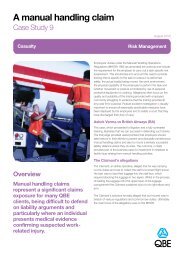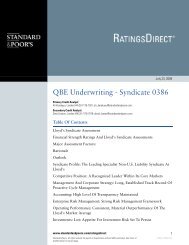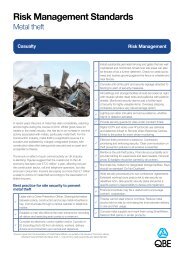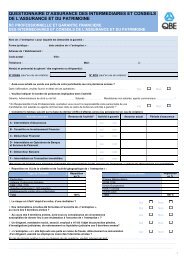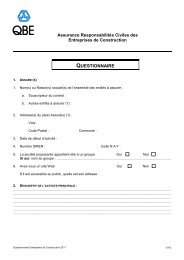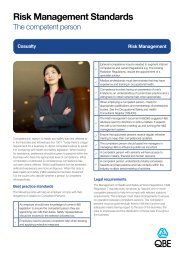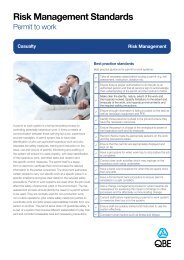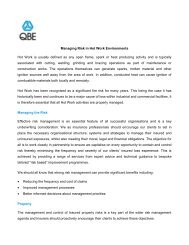QBE European Operations plc
QBE European Operations plc
QBE European Operations plc
You also want an ePaper? Increase the reach of your titles
YUMPU automatically turns print PDFs into web optimized ePapers that Google loves.
<strong>QBE</strong> <strong>European</strong> <strong>Operations</strong> <strong>plc</strong> Annual report 2011<br />
52<br />
Notes to the financial statements<br />
continued<br />
For the year ended 31 December 2011<br />
1 Accounting policies continued<br />
depreciate all properties, which conflicts with SSAP 19. The directors<br />
consider that, as these properties are held for investments, to depreciate<br />
them would not give a true and fair view, hence it is necessary to adopt<br />
SSAP 19.<br />
h) Taxation<br />
The charge for taxation is based on the result for the year adjusted for<br />
disallowable items. Deferred taxation is measured on an undiscounted<br />
basis at the tax rates that are expected to apply in the periods in which<br />
timing differences reverse, based on tax rates and laws enacted or<br />
substantively enacted at the balance sheet date. Deferred tax assets are<br />
recognised to the extent that it is regarded as more likely than not that<br />
they will be recovered.<br />
i) Investments<br />
Except where noted below, all investments are designated as fair value<br />
through profit and loss on initial recognition. They are initially recorded<br />
at fair value, being the cost of acquisition excluding transaction costs<br />
and are subsequently remeasured to fair value at each reporting date.<br />
Financial assets are managed on a fair value basis in accordance with<br />
the Group’s documented investment strategy.<br />
Listed investments are stated at fair value on current bid prices quoted<br />
by the relevant exchanges. Unlisted investments are carried at the<br />
directors’ estimate of the current fair value.<br />
Derivatives are initially recognised at fair value on the date on which<br />
a derivative contract is entered into and are subsequently stated at<br />
fair value determined using generally accepted valuation techniques,<br />
including the use of forward exchange rates for the valuation of forward<br />
foreign exchange contracts.<br />
Loans to Group undertakings are stated at amortised cost converted<br />
at the relevant exchange rates at balance sheet date.<br />
Financial assets are derecognised when the right to receive future<br />
cash flows from the assets has expired, or has been transferred<br />
and the Group has transferred substantively all the risks and rewards<br />
of ownership.<br />
j) Hedging transactions<br />
Derivatives held for risk management purposes which meet the criteria<br />
specified in FRS 26 are accounted for using net investment in foreign<br />
operating hedge accounting or cash flow hedge accounting.<br />
When a financial instrument is designated as a hedge, the Group<br />
formally documents the relationship between the hedging instrument<br />
and hedged item as well as its risk management objectives and its<br />
strategy for undertaking the various hedging transactions. The Group<br />
also documents its assessment, both at hedge inception and on an<br />
ongoing basis, of whether the hedging instruments are highly effective<br />
in offsetting changes in cash flows of hedged items.<br />
Hedge accounting is discontinued when:<br />
• it is determined that a derivative is not, or has ceased to be, highly<br />
effective as a hedge;<br />
• the derivative expires, or is sold, terminated or exercised; or<br />
• the hedged item matures, is sold or repaid.<br />
For qualifying hedges, the fair value gain or loss associated with the<br />
effective portion of the hedge is recognised initially directly in reserves<br />
and transferred to the profit and loss account in the period when the<br />
hedged item will affect profit or loss. The gain or loss on any ineffective<br />
portion of the hedging instrument is recognised in the profit and loss<br />
account immediately. When a hedging instrument expires or is sold,<br />
or when a hedge no longer meets the criteria for hedge accounting,<br />
any cumulative gain or loss existing in equity at that time remains in<br />
reserves and is recognised when the hedged item affects the profit and<br />
loss account. When a transaction is no longer expected to occur, the<br />
cumulative gain or loss that was recognised in reserves is recognised<br />
immediately through the profit and loss account.<br />
k) Financial liabilities<br />
Creditors are initially recognised at fair value, net of directly attributable<br />
transaction costs and are subsequently stated at amortised cost through<br />
the profit and loss account using the effective interest method. The<br />
exception being derivatives are initially recognised at fair value on the date<br />
on which a derivative contract is entered into and are subsequently stated<br />
at fair value determined using generally accepted valuation techniques,<br />
including the use of forward exchange rates for the valuation of forward<br />
foreign exchange contracts.<br />
l) Shares in Group undertakings<br />
Shares in Group undertakings are included in the company’s balance<br />
sheet at cost less any impairment, based on the directors having prudent<br />
regard for their likely realisable value. Dividends from Group undertakings<br />
are taken into account when the right to receive payment is established,<br />
for interim dividends, when they are paid and, for final dividends, when<br />
they are approved by shareholders.<br />
m) Investment income<br />
Interest income is recognised on an accruals basis. Dividends are<br />
recognised when the right to receive payment is established. Investment<br />
income includes realised and unrealised gains or losses on financial<br />
assets which are reported on a combined basis as fair value gains or<br />
losses on financial assets.<br />
A transfer is made from the non-technical account to the technical account<br />
of the return on investments supporting the insurance technical provisions.<br />
n) Realised and unrealised gains and losses<br />
Realised gains and losses on investments carried at fair value through<br />
profit and loss are calculated as the difference between net sales<br />
proceeds and purchase price.<br />
Unrealised gains and losses represent the difference between the<br />
valuation of the investment at the balance sheet date and their purchase<br />
price, or if they have been previously valued, their valuation at the last<br />
balance sheet date, together with a reversal of unrealised gains and<br />
losses recognised in earlier accounting periods in respect of investment<br />
disposals in the current year.<br />
All realised and unrealised gains and losses on investments are initially<br />
recorded in the profit and loss non-technical account. A transfer is made<br />
from the non-technical account to the technical account of the realised<br />
and unrealised gains and losses on investments supporting the insurance<br />
technical provisions.<br />
o) Foreign currency translations<br />
The functional currency of the company is UK pound sterling (£). The<br />
company and Group present its accounts in thousands of pounds sterling.



